Abstract
Social housing constitutes a partial response to the demand for affordable housing. In Europe, there are different forms of social housing, which are distinguishable based on whether they employ a universal or residual approach. The latter is employed by Italian initiatives for social residential construction, the financial instrument of which is the Investment Fund for Housing, a closed-end fund managed by CDP (Cassa Depositi e Prestiti) Investment, which provides public–private partnerships. The main obstacle to the supply of low-cost houses is the high cost of building areas or, in other words, the high urban land rent. The value of building areas is particularly high in urban areas and in widespread settlement areas, for instance, in Northeastern Italy. The main objective of this paper is to identify the trade-off between urban land rent and housing affordability in a social housing intervention in Pordenone (Northeastern Italy). Four different scenarios are developed, the variables of which are: Cost of the area (urban rent), cost of construction works (quality of the buildings), and household income distribution. The results show that achieving the economic and social objectives of a social housing investment simultaneously is not possible in any of the scenarios evaluated. To allow the social groups most in need to access affordable housing would require a reduction of approximately 30% of the estimated cost of a building area.
1. Introduction
Social housing constitutes a partial answer to the demand for low-cost housing. In Europe, there are various forms of social housing, which are distinguishable based on whether they employ a universal approach—in which the State guarantees the right to housing, and Social Housing acts as a calmer of the market—or a residual approach—in which the State intervenes to compensate for market failures. The latter approach includes national initiatives for social residential building, the financial instrument of which is, in Italy, the Fondo Investimenti per l’Abitare (FIA), a closed-end real estate fund managed by CDP (Cassa Depositi e Prestiti) Investment Sgr, which provides for public and private partnerships.
One of the most relevant and critical aspects of social impact investing (SII) operations concerns the measurement of social impact [1,2], defined as “the portion of the total outcome that occurred as a direct result of the intervention, i.e., not including that part that would have taken place equally without the intervention” [3].
Social housing can be traced back to the so-called affordable housing approach. This approach was widespread in Europe, the USA, Canada, and Australia in the 1980s and requires that the satisfaction of housing needs does not affect a person’s ability to meet other basic needs, such as food and health care. Often, an inadequate supply of affordable houses causes spatial segregation for low-income households [4].
In all settlement processes, and thus also in those with a social value, the issue of land rents takes on a very important meaning in all cases in which, aside from the objectives of the investment, a minimum economic return for the developer is achieved. In fact, urban land price is one of the most important production costs of a building.
This paper aims to investigate a possible trade-off between urban rent and housing affordability in a social housing investment, located in Pordenone in the northeast of Italy. The analysis conducted in this study is developed with reference to Giovanni Cechet’s project, conducted in his master’s degree thesis, and is based on some specifications agreed at a preliminary stage by the FVG (Friuli-Venezia Giulia) Housing Social Consortium, which is the promoter of a real intervention on the same plot.
2. State of the Art
2.1. Housing Affordability
The theme of social housing is of interest to the scientific communities that deal with social sciences, urban planning, architecture, and engineering. Beyond the purely technical and technological aspects, the social value of this type of intervention is an aspect on which these different scientific communities focus more closely.
By introducing the concept of housing affordability, it is useful to distinguish market (business as usual) and planner point of view. The point of view of the first is that of those who evaluate the potential market demand with respect to the placement price of the houses to understand if there is an adequate ‘absorption’ potential at a price that they consider profitable (full cost criterion in a monopolistic competition market as it is for new buildings). The planner point of view, however, concerns the policy maker who wants to evaluate the market’s ability to provide accommodation at an affordable price and, otherwise, to identify adequate measures to solve the need. The compression of urban rent is one of these tools. The problem is often to determine how much urban rent must be compressed without violating the rights of landowners. Our contribution focuses on this.
There are different approaches to affordable housing, which are classified as follows [5].
- Categorical: A statement of the ability or inability of households to pay for market housing, but without a measurement foundation.
- Relative: Changes over time in the relationship between housing costs and household incomes.
- Subjective: Whatever individual households are willing or choose to spend.
- Family budget: Monetary standards based on aggregate housing expenditure patterns.
- Ratio: Maximum acceptable housing cost/income ratios.
- Residual: Normative standards of a minimum income, required to meet non-housing needs at a basic level after paying for housing.
Among these approaches, the ratio approach has the longest history and widest recognition in assessing affordability.
Furthermore, one of the main problems related to social housing interventions concerns the measurement of their social impacts. In the scientific literature, it is possible to identify quantitative, monetary non-monetary, and qualitative approaches. However, it appears somewhat difficult to standardize the measurement process, as less binding approaches and case-specific approaches are almost always preferable [6], although it is possible to identify attempts to classify the different available approaches [3].
A recent study set in the province of Siracusa [7], which involved seven municipalities, dealt with the issue of housing problems and their resolution through traditional and innovative planning tools. In particular, the analysis aimed at identifying the problems was carried out using data on the distribution of wealth, in terms of incomes, house prices, and income thresholds that filter access to the real estate market. The results show that many families do not have sufficient income to access the real estate market, and at the same time, their income is too high for them to access public housing.
Another study [8], set in Palermo, investigated the real estate market and the income thresholds to highlight the operational and critical aspects related to household accessibility to the free market and estimate the financial gap corresponding to the impossibility of accessing housing.
On the other hand, some works have focused on the analysis and application of the social return on investment (SROI) methodology, aimed at measuring the extra-financial value with respect to the invested resources [2,9,10]. For example, by applying a social housing redevelopment intervention in Rovereto, a recent study investigated the potential of this method to provide decision makers with an integrated multi-objective evaluation tool [11].
Other studies have focused on the relationship between the accessibility of housing and the need to build sustainable housing from an environmental and economic point of view. Among these, a very recent study [12] focused on the identification and classification of different critical success criteria (CSC) for measuring the sustainability performance of so-called affordable housing through a global review of the literature. In this area, another similar work, set in China [13], investigated the problems associated with integrating various aspects of sustainability in social housing projects, aiming to identify key sustainability performance indicators that can perform the task of guiding the development of social housing projects.
However, the challenge that this study specifically intends to face remains to be investigated, that is, the relationship between the urban rent of soils (and therefore the value of the areas) and the feasibility of social housing interventions in terms of social and economic objectives.
2.2. Urban Rent
Studies concerning urban rent originally defined it as “the price paid for land use” [14]. In this definition, rent represents the characteristics of soils that contribute to their productivity. According to Marx, the birth of rent theory is to be attributed to Anderson [15], who defines rent as what is paid for the use of the most fertile soils and therefore as the differential price for the use of a specific quality.
In the early nineteenth century, some authors proposed a definition of residual rent. Malthus [16] states that rent is the difference between the market price and the cost of production, while Ricardo specifies that the cost of production is that determined by the cost of labor on the least fertile land [17]. The last classical economist who debated the concept of rent is Marx, who introduced the distinction between differential and absolute rents [18]. Differential rent originated from the various soil rates (Ricardian rent), while absolute rents originated in cases where the soil regime tends toward a monopoly condition. Von Thünen [19] made the first contribution that links rent more directly to location and less to soil fertility. He notes that the prices of agricultural goods also depend on transport costs between the production site and marketing centers. To a lower cost of transport he therefore attributes a higher value added from the sale of a product.
Land rent definitely represents the remuneration to the owner of the natural production factor, i.e., soil in this case. In practical terms, urban rent can be defined as the difference between the value of the built-up land and the sum of the depreciated value of capital invested in public infrastructure, the depreciated value of the buildings constructed and the agricultural value of the land itself.
The definitive analytical contribution to the theory of rent and its influences in the urban environment [20] were given by Alonso [21], who formalized von Thünen’s principle of accessibility to the location of productive and residential activities in urban structures. The dynamic aspect of rent introduces the question of the balance between demand for accessibility and rent supply, i.e., between location and urban rent.
In the case of interest, i.e., residential activities, in this study, the propensity towards central locations develops competition that affects the price level of the relative areas and urban income levels. Since residential costs are not only related to the location, but also to the size of the apartments, it follows that once you have defined the income you expect to spend, you can allocate this expenditure between the costs related to the size of the apartments and those arising from the location. The choice of the equilibrium point is made according to the structure of the individual utility function, as shown in Figure 1.
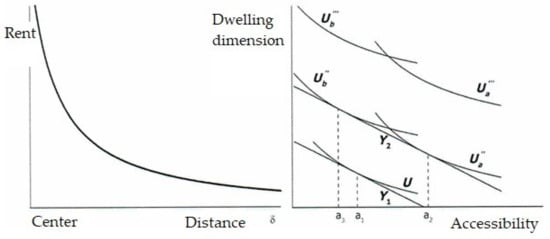
Figure 1.
Relation between the rent and location of residential units, adapted from Reference [20].
As the total income spent increases (from Y1 to Y2), individuals who belong to families of lower indifference curves (U’’a and U’’’a), and for whom accessibility to the center is a higher asset, will tend to favor the latter, even at the cost of reducing the dwelling size. On the contrary, individuals who express the higher curves of indifference (U, U’’b, U’’’b), for whom the higher good is represented by the size of the apartment, will favor this option over accessibility.
There are also more specific aspects that link urban rent to the urban environment, in addition to the distance from the urban center. For example, the presence of green urban spaces affects the value of properties and even differently according to the type of urban green spaces [22].
Recently, the concept of ‘pure rent’ was introduced. It refers to the deviation of rent itself from real economic values to integrate with financial ones [23]. In fact, an analysis carried out in France on the time series from 1850 to 2008 showed that the ratio between real estate values and purchasing power remained constant over the long term, while rent increased significantly in the 1990s, which is unrelated, as mentioned above, to real economic values and integrated with financial values [24]. In those years, in fact, the real estate fund instrument took hold, which allows for the inclusion, in a single investment portfolio, of the properties of multiple properties involving even small investors. From that moment on, the valorization of the building transformation was only partially linked to the physical conditions of the building, while it was more connected to the macroeconomic trends deriving from financialization.
The formation of pure rent has had important effects on the rental market, especially for the lower-middle income groups, which have been the protagonists of a progressive phenomenon of migration towards the hinterland of the cities.
In Italy, the end of the fair rentals regime in 1998, in the absence of a reform of social housing policies, favored the formation of pure rent and therefore the speculation of large investors through the instrument of the real estate fund. In this regard, an interesting study of the Italian real estate market [25] investigated the cause and effect relationship between property sales prices and rents. It was found that house prices can influence rents, but not the other way around. In the past decades, the demand for housing in Italy, even for investment, does not consider rent as a proxy for the corresponding dividend.
The governance of land rents, in the context of social impact investing, is a determining element in creating both social and economic value. In this case, public actors who can provide low-cost abandoned areas play a fundamental role.
For example, a recent study [26], which partially focused on the theme of the regeneration of abandoned urban areas (social aspect) in the context of public-private partnerships, developed and tested a model that aims to determine a series of combinations of urban planning parameters. These parameters have to be attributed to abandoned areas capable of reflecting the right distribution of burdens and financial advantages (economic aspect), which is the basic reference for bargaining between public and private entities. The results confirm the potential and flexibility of the model, as well as the possibility of implementing urban regeneration strategies that ensure minimum financial returns.
This contribution, through a cash flow analysis, investigates the economic feasibility and social impact of a social housing project in the northeast of Italy in order to explore the trade-off between urban rent and social value, i.e., the satisfaction of housing needs for households that cannot access public housing and the free market.
In fact, with the advancement of technology in the field of construction and the need to respond to increasingly stringent regulatory requirements in order to ensure an adequate energy and environmental performance of new buildings, the possibility to lower construction costs seems limited, even for the construction of affordable housing. In this situation, the achievement of the set economic return on the investment, which, together with the achievement of the social objective, represents the main objectives of social housing interventions, is strongly dependent on the market value of the area and therefore on urban rent.
3. Methodology and Application
The proposed methodology aims to define a trade-off between urban rent and social value in the context of a social housing investment, such as the one presented, on the basis of some specific assumptions concerning the affordable housing approach, which will be illustrated below.
As mentioned, from the operational point of view, the research is based on a cash flow analysis of a social housing intervention over a time horizon of 18 years. The aim of the research is not to assess the economic sustainability of the investment, but rather to determine which are the household income ranges that, according to the concept of the affordable housing, can access social residential buildings by guaranteeing a real economic return target of 3%, i.e., the net inflation. The expected return value is established by FIA [27]. This value lies between the risk-free investment return and plausible returns of a property developer in business as usual conditions. Considering that the placing on the market of housing at prices lower than market prices entails lower risks than those characterizing a traditional real estate investment, the rate assumed is considered consistent.
The analysis will be characterized, as described below, by the variability of the cost of the area and of the construction works.
With reference to the concept of affordable housing, understood as the ability to access a home with a reasonable economic effort of a family unit, it is necessary to define income brackets, from which, applying the commonly used rate of 30%, an affordable fee/mortgage installment can be calculated.
The calculation is performed as follows:
where:
- Cacc is the affordable house annual fee/mortgage instalment;
- Rnf is the net family income;
- Sgm are the costs of management and maintenance.
Housing management and maintenance costs are proportional to the size of the dwelling and are assumed to be equal to €10/sqm per year.
The affordable prices of each dwelling are determined by calculating the present value of the installment Cacc in addition to the advance Ant, which is calculated as follows:
This is equal to 20% of the instalment due for the overall contract period. The duration of the loan has been set at 20 years (for families of up to three members), 25 years (duration of the loan for family units of four members), or 30 years (for families with more than four members) as follows:
where:
- Pconc is the affordable price;
- r is the fixed rate of bank interest, equal to 2%;
- n is the duration of the loan (20, 25, or 30 years);
- Ant is the advance.
The rent with ransom is given by the sum of the pure rent plus an advance on the redemption at the end of the lease.
where:
- Qloc is the portion of the pure rent;
- Qant is the portion of the advance on the ransom.
The advance on the redemption is equal to 20% of the affordable price for the sale of the dwelling Pconc and is distributed in 8 years or 15 years, depending on the duration of the lease, before the redemption:
where:
- m is the duration of the lease (8 or 15 years).
Finally, the redemption price (Prisc), provided that there is no revaluation of the property value, is equal to:
4. Case Study
4.1. The Social and Economic Context
The case study is located in the municipality of Pordenone, which, together with its entire province, has seen a constant development, from 1990 to 2006, of widespread urbanized areas using low-density solutions (Figure 2).
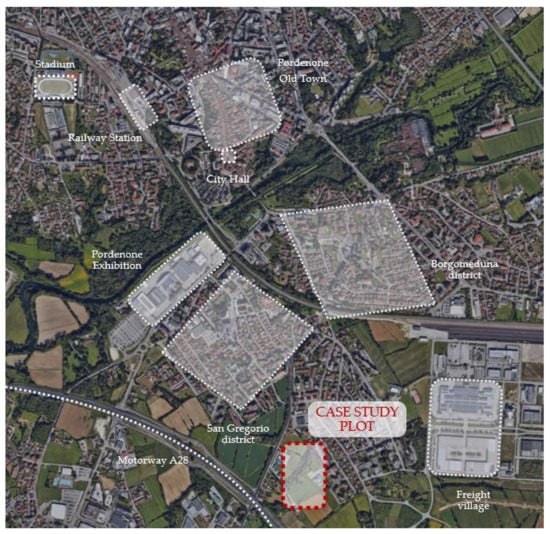
Figure 2.
Location of the case study in the context of Pordenone Municipality (satellite view by Google Maps®).
From an economic point of view, the entire province had an economic trend that went against the trend during the crisis: The level of employment between 2007 and 2011 showed an increase of almost 3%. This testifies to a strong industrial sector.
Unlike in the 2000s, the Pordenone residential context has witnessed a recent migration, that is, a return from the peripheral areas to the central ones. This growing demand is opposed by an inadequate offer of both used and new buildings.
With regard to the income data, reference was made to the report, “Life, Income and Physical Health of Families, 2017” (Italian National Institute of Statistics, ISTAT 2018), which shows the net average and median family incomes by the number of components (Table 1).

Table 1.
Net household income for the northeast of Italy, 2017 (source: Italian National Institute of Statistics—ISTAT).
As can be seen, the median income is lower than the average, and this indicates that there is a concentration of income in the higher income range. To obtain information on the distribution of wealth, we use the Gini concentration index IG, which is formulated as follows:
where:
- Qi are the cumulative percentages of income;
- Pi are the cumulative percentages of income in the case of equal distribution.
A value of 0 indicates that all families receive the same income, and a value of 1 indicates that the total income is received by a single unit.
For Northeastern Italy, ISTAT provides a Gini index for 2017 equal to 0.279, which is the lowest in Italy in that year. In the south and the islands, the index is 0.334; in the center, it is 0.318; and in the northwest, it is 0.311.
From 2004 to 2011, requests for contributions to the National Fund to support access to rented dwellings received by the municipality of Pordenone were in constant growth (from 247 to 620 applications). On the other hand, in the same period, the funds available decreased from an outstanding percentage of requests of just over 50% in 2009 to almost 75% in 2011. Even the accommodations made available as public residential buildings were not enough to meet the demand. In this context, the implementation of social housing interventions is justified for the following reasons: The offer does not meet the demand, the population is growing, and even the public residential building accommodations do not meet the specific needs.
The following section illustrates the physical characteristics of a social housing project in the municipality of Pordenone.
4.2. The Project
The project under analysis involves the construction of five buildings. The design choices have led to the adoption of non-traditional technological solutions, such as the creation of green roofs, since these can offer benefits not only to the private individual, but also to the community [28,29] (Figure 3).
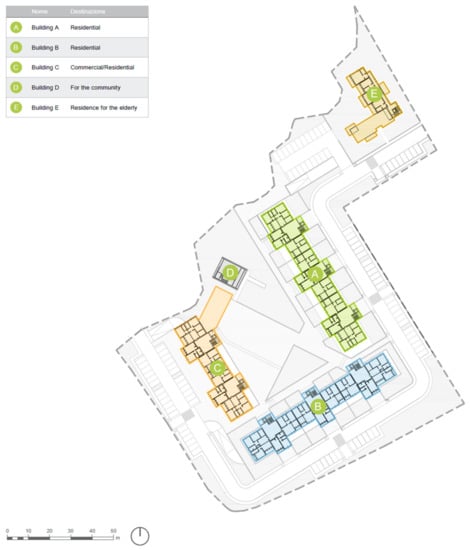
Figure 3.
General plan of the intervention and identification of the buildings.
Buildings A, B, and C are for residential use and provide the following subdivision of houses in relation to the number of occupants, as shown in Table 2. On the ground floor, building C also houses commercial units and services, with a total area of approximately 560 square meters.

Table 2.
Subdivision of dwellings.
Building D is intended for the community. In fact, the designer has taken into account that, for social residential buildings, i.e., interventions of modest dimensions, such as the one in question, it is also advisable to provide real estate units capable of favoring social aggregation. Building E will host a residence for the elderly. In this regard, it is good to specify that the original destination assigned to the urban area relates to welfare activities for elderly people.
For this reason, the agreements made with the local authority by the promoter of the real intervention, Consorzio Housing Sociale FVG, also allow for the construction of a real estate unit intended for social housing.
The basement floor of buildings A, B, and C will host parking spaces and technological substations.
4.3. The Investment Cost
In a real estate investment, the cost of the area is one of the most significant items determining whether or not the investment will be profitable. Given the high technological complexity that characterizes new buildings, the value of the area is perhaps the only item, among the costs of an investment, that could be compressed.
The cost of the area has been estimated by direct comparison with building areas located in the same peripheral area of the city of Pordenone, taking into account the total lack of urbanization of the area of interest, resulting in a unit value of €75/cbm of building volume, with a total area value of €2,224,500.00. This value has been subject to changes in the scenario, which will be included in the results section to investigate, in qualitative and quantitative terms, the influence of the cost of the area on the economic return on the investment. The construction cost is estimated using a survey on the local construction market, taking into account the scale economies due to the size of the intervention. This cost item always retains a characteristic of variability. Therefore, this cost was also varied within the simulations. Table 3 reports the “most likely” values of the various building components.

Table 3.
Most likely values.
For these values, the total construction cost is estimated at €10,150,312.50, with an incidence on the building areas of approximately €1150/sqm. Of the total, the primary urbanization works amount to €532,312.50. In the scenario analysis, the construction value of the buildings will be varied to capture its influence on the overall return on investment. The other costs will not be considered as variables for the purposes of the calculation.
In Italy, authorization costs are divided into primary and secondary urbanization charges and contribution to construction costs. Costs occurred in carrying out primary urbanization, which was deducted from the primary urbanization charges. The contribution to the construction cost is due in relation to the cost itself, estimated in accordance with specific parameters provided by the municipality. This contribution is always due for new construction interventions. In the case study, the costs for primary urbanization works are higher than the charges due to the municipality, and therefore, the latter are not due. Secondary urbanization charges are always due for social services supporting an urban settlement, such as nurseries, schools, and shops. The costs of secondary urbanization and the contribution to the construction cost have been estimated using the unit values and the rates of the municipality of Pordenone and amount to €489,013.02.
The technical costs, including the fees for architectural and specialist planning, specialist reports, works management, testing, safety coordination, and stacking, are generally calculated as a lump sum through a rate on the construction cost. The value of this rate varies between 10% and 5%. An average rate of 7.5% is adopted.
Under general and unexpected expenses are considered those expenses related to the organizational structure, which is put in place for the investment. To these are added the expenses related to possible unforeseen events. They are estimated considering a rate on the construction and technical costs. A rate of 5% is usually adopted.
In order to advertise and market the real estate units, whether they are rented or sold, it is appropriate to take into consideration the relative expenses. Additionally, in this case, this cost is estimated in a simplified way by applying a rate to the value of the sold or monthly rent. This rate usually varies between 2% and 5%. Since this is an intervention of social value, a rate of 2% is adopted.
The management costs of the rented accommodation are assumed to be equal to 5% of the annual rent and distributed over the entire duration of the lease.
For a social housing intervention, as stated by the FIA regulation, unlike a normal private building intervention, it is important to consider a further cost, that is, the one linked to the social project. This is also calculated as a rate and is reasonably assumed to be equal to 2% of the construction cost.
Part of the capital invested is in debt. The “Statistical Bulletin 2017” of the Bank of Italy shows that, for Northeastern Italy and for loans over 5 years, the interest rates applied to non-financial companies related to the construction sector are equal, at 2.44%. Considering that for these types of investments, which cover a social value, bargaining on the interest rate is highly probable, a rate of 2% can realistically be assumed. From the same source and for the same conditions, we note an active interest rate of 0.08%, which is assumed to be 0%.
Finally, the last cost item to be considered concerns taxes on profit. Social housing initiatives, which are usually undertaken through the financial instrument of the real estate fund, such as the one in question, are subject to a particular tax regime, which does not provide for the taxation of corporate income and regional tax on production activities. For the purposes of taxation, the assets of the real estate fund remain suspended until the profits are distributed, at which point a withholding tax of 26% must be applied.
4.4. Estimation of Investment Revenues
The different foreseen uses of the intervention can be classified as residential, commercial, social, or assistance. As for the residential use, which obviously represents the most consistent part, the investment revenues derive partly from sales at affordable prices and partly from rent, with a redemption at the end of a period of 8 or 15 years. The analyzed scenario foresees that 60% of the accommodations will be sold immediately, 20% will be leased for 8 years and then redeemed, and the remaining 20% will be leased for 15 years and then redeemed, as per in Table 4.

Table 4.
Distribution of costs and revenues over time.
The commercial real estate units, the building for the community and the care building for the elderly will produce revenues following the sale on the free market.
5. Discussion of the Results
This section reports the results of the application of the method described above in a case study. As already mentioned, the objective of this work is to evaluate the trade-off between urban rent and the social value of the investment, considered as the size of a social group whose income allows for access to social housing policies but not to the free market sector. In this way, the intended economic return of 3% is guaranteed. To do this, the results of the different scenarios considered are defined below in Table 5.

Table 5.
Scenario definitions.
5.1. Business as Usual Scenario
The minimum income for accessing the free housing market has been calculated, considering a promoter of private investment, with the following assumptions:
- Cost of the building area: €75/cbm (most likely market value);
- Cost of building works: €1200/sqm;
- Discount rate (net of inflation): 5.5%.
The discount rate was determined according to the capital asset pricing model:
where:
- r is the discount rate (expected minimum nominal return on the investment);
- rf is the risk-free investment return (assumed to be 1%);
- β is the systemic risk coefficient of the investment (assumed to be equal to 1 for the real estate sector);
- rm is the return on a market investment (assumed to be 5%);
- rs is the specific risk on the investment (1.6%, according to the Manuale Operativo delle Stime Immobiliari MOSI procedure [30]).
Coefficient β defines the systematic risk in a business activity, compared to the average equity market risk. β increases proportionally to the activity’s expected return increase due to a higher non-diversifiable risk. Assuming an inflation rate at 1%, we obtain a real discount rate of 5.5%.
Based on these inputs, the minimum incomes needed to buy a home of the same quality as those proposed in the social housing project have been calculated. The results are shown in Table 6.

Table 6.
Minimum income for free market access.
5.2. Scenario 1: Null Cost of the Building Area and Most Likely Cost of the Building Works
In this scenario, following the discounted cash flow DCF model, the most likely values, reported in Section 3, were assumed to be as follows:
- Cost of the building area: €0/cbm;
- Cost of building works: €1000/sqm.
For this scenario, the income simulation, in which the investment is economically viable, is reported in Figure 4.
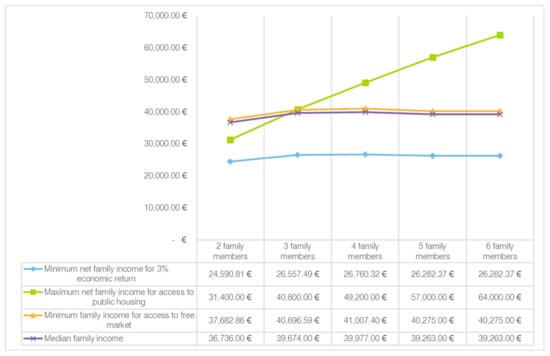
Figure 4.
Minimum income to guarantee economic performance under the boundary condition of Scenario 1.
The assumptions underlying this scenario could be traced back to the case in which the area is made available free of charge by the public administration. This hypothesis represents the case, for example, in which the areas granted are bearers of negative externalities that are resolved through the intervention of social housing.
In this scenario, for the purpose of a correct analysis of the results, it is necessary to distinguish the income brackets of the two-member households and those with three or more components. For the former, it is reasonable to assume that, although they have an income that allows them to access public housing, they are excluded from the rankings of the assignment in favor of significantly lower incomes and, at the same time, cannot access the free market. As for the latter, on the other hand, it is likely that they could be assigned to public housing. Therefore, in this scenario, if on the one hand, the economic return is guaranteed, on the other hand, the social objective is only partially achieved.
5.3. Scenario 2: Variable Building Area Cost, Variable Cost of Building Works, and Income of Scenario 1
In this scenario, the variables have been set as follows:
- Cost of the building area: Variable between €0 and €75/cbm;
- Cost of building works: Variable between €800 and €1200/sqm.
The incomes considered for the calculation of the rent, sustainable installment and, therefore, housing prices have been determined on the basis of the income in Scenario 1.
In Figure 5, the simulation results are represented, where, on the y-axis, we find the economic return as a percentage and, on the x-axis, we find the cost of the building area. Each curve represents the values of the economic return, with variations in the cost of the area, for each of the fixed values for the cost of the building works (€800, €900, €1000, €1100, and €1200 /sqm).
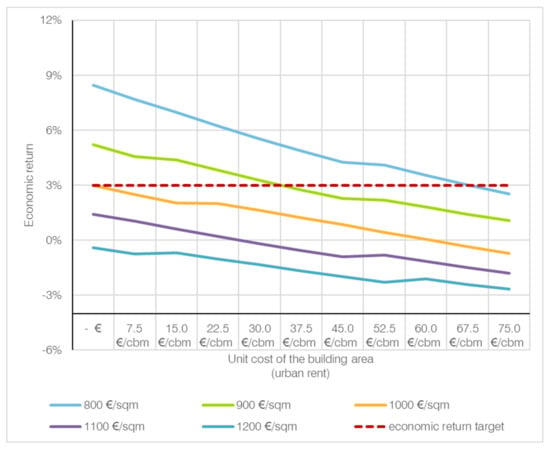
Figure 5.
Trend of economic return in relation to the cost of the building area and building works.
It should be noted that, for the costs of building works exceeding €1000/sqm, in the income range considered, and therefore on the basis of the associated affordable prices, the economic return target is never reached, and the building area cost even reaches zero. Assuming a construction cost of €900/sqm, the investment achieves a minimum profitability of 3% only by halving the market value of the building area. If the construction cost is reduced to €800/sqm, the minimum return is achieved by reducing the market value of the building area by 10%.
Figure 6 shows the cost of the building works, i.e., the unit cost of the area limit curve, above which all the combinations for which the return is less than the target of 3% are placed and below which are found all the combinations for which at least a 3% economic return is guaranteed.
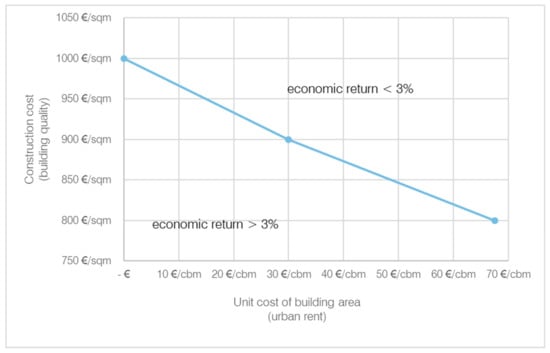
Figure 6.
The trade-off between the building area cost and construction cost.
5.4. Scenario 3: Free Market Cost of the Building Area and Maximum Cost of the Building Works
In this scenario, we look for the income range in which we can reach the economic target by setting the following conditions:
- Cost of the building area: €75/cbm (estimated value, maximum hypothetical);
- Cost of the building works: €1200/sqm (maximum hypothetical).
The minimum incomes that are convenient for the investment from an economic point of view are reported in Figure 7.

Figure 7.
Minimum income to guarantee the economic return target under the boundary conditions of Scenario 3.
The assumptions underlying this scenario could be traced back to the case in which the area is purchased at market value directly from the private individual and the technological solutions adopted for the construction of the buildings are such that the cost of the works is the maximum inside of the assumed range.
In this case, it is appropriate to distinguish between the income range of the two-component and that of the three-component units too. The former has an income higher than the maximum acceptable for access to public housing. However, they do not yet reach the minimum income values for access to the free market. The three-component units, on the other hand, have an income lower than the maximum allowed for access to public housing.
In this scenario, therefore, the social target is not satisfied for any family unit. In Figure 8, we observe the frequency distribution of income for a family composed of two people. The orange area (36%) represents households whose income is lower than the maximum expected for access to public housing. The blue area represents (9%) households that cannot access the free market but nevertheless have a suitable income to access social housing. The purple area (7%), on the other hand, represents those households whose income is higher than the maximum for access to public housing and lower than the minimum for access to social housing and whose housing needs, therefore, are not in any way satisfied.
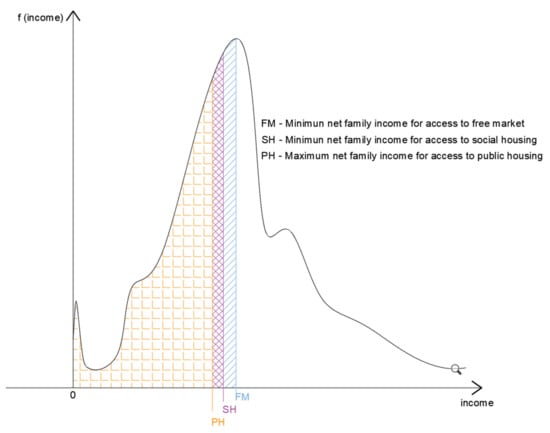
Figure 8.
Frequency distribution of the net income for families of two people in Pordenone.
5.5. Scenario 4: Null Cost of the Building Area and Minimum Cost of the Building Works
In this scenario, we look for the income range in which we can reach the economic return target by setting the following limit conditions:
- Cost of the building area: €0/cbm;
- Cost of building works: €800/sqm (conceivable minimum).
The minimum incomes that are convenient for the investment, from an economic point of view, are reported in Figure 9.
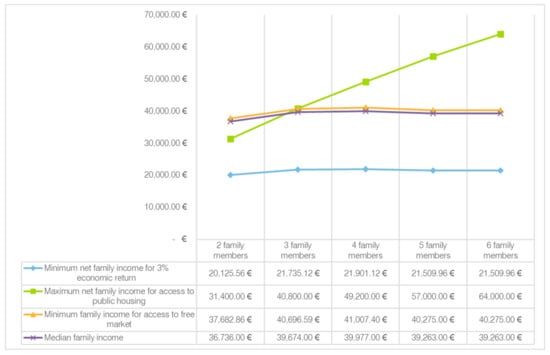
Figure 9.
Minimum income to guarantee the economic return target under the boundary conditions of Scenario 4.
The assumptions underlying this scenario are similar to the first, with the difference that the technological solutions adopted for the constructions are of low level and therefore the relative cost is equal to the minimum in the hypothesized range of values.
This limit scenario allows relatively low-income groups to access housing from the social housing project using sustainable installments or rents. In fact, considering areas that have zero costs and with very low costs associated with building works, a condition is created in which the achievement of the economic return target is feasible, even for income groups that can potentially access public housing. However, in this case, the social objective, which is to provide for income groups that cannot access either public housing or the free market to find dwellings at affordable prices, is not achieved.
Table 7 provides a summary of the results obtained in each scenario.
6. Concluding Remarks
This study investigated the relationship between urban rent and accessibility to social housing in the case of a project set in an area characterized by widespread economic development and urban sprawl. Assuming a real economic return target of 3%, through a cash flow analysis of the investment, various hypotheses were evaluated by varying the building area cost and construction cost to verify whether and in which cases both objectives were met: The social and the economic ones.
Scenario 1 considers the cost of the building area to be equal to zero, and the most likely cost of the building works is taken to be €1000/sqm. The simulation shows that if, on the one hand, economic performance is guaranteed, on the other hand, the social objective is only partially achieved. In fact, for families with two people, it is reasonable to assume that, although they have an income that allows them to access public housing dwellings, in the assignment rankings, they are excluded in favor of significantly lower incomes. This is because the public housing offer fails to meet the entire demand, and such families therefore fall within the social housing beneficiary range, as they cannot access the free market due to insufficient income. Families with multiple components, on the other hand, can access public housing and therefore do not fall within the target of the evaluated intervention.
Scenario 2 demonstrates how the two cost variables (building area and construction) significantly affect economic and social returns, highlighting how for costs of building works exceeding €1000/sqm, for the income brackets considered, and therefore on the basis of the associated affordable prices, the economic return target is never reached and even makes the area cost zero.
Scenario 3 leads to the conclusion that, considering the cost of the area at the most likely market value and the maximum simulated building cost of €1200/sqm, the social and economic goals can be achieved simultaneously only for households with two people and for a limited range of income.
Scenario 4, with hypothetical minimum values, allows relatively low-income groups to access social housing, with sustainable installments or rents. These social groups are those that can potentially access public housing. However, in this case, it is believed that the social objective of providing dwellings at affordable prices for the income groups that cannot access either public housing or the free market is not achieved.
The analysis has highlighted how urban rent and the quality of buildings significantly influence the effectiveness of social impact investing. In fact, the social brackets whose incomes allow for access to social housing and, at the same time, allow the minimum economic return target to be realized are broadened and reduced, as a function of both the rent paid to the owner of the land and the quality of the buildings. In this sense, we can identify the trade-off between urban rent and social value: With a decrease in the rent paid to the landowner, social groups whose income allows for access to social housing increase.
Finally, the aforementioned concept of affordable housing is understood as a family unit’s ability to access a home with a reasonable economic effort. This “reasonable effort” was considered to be equal to 30% of the gross income of house maintenance expenses. It is believed that a greater articulation of the concept would be appropriate. Assuming, in fact, for a family unit made up of two people, with a net income of €30,000.00, after deducting 30% of home expenses a net income of €21,000.00 remains for other family expenses and €10,500.00 per component. If, on the other hand, we assume a family unit made up of four people with the same income, the share of household expenses is the same, while the share of income per component to be allocated to other expenses is half and equal to €5250.00.
It would, therefore, be appropriate to include the variable, “composition of the family unit,” in the concept of affordable housing in order to ensure that the share of income, equal to 30%, that is allocated to housing costs is not too high for large households. In this sense, a possible development of the research could concern the use of different metrics for affordable housing, such as the residual income approach.
Author Contributions
Conceptualization, P.R. and R.B.; methodology, P.R. and R.B.; validation, R.B., G.C., and P.R.; formal analysis, C.A.S.; investigation, G.C. and R.B.; data curation, G.C.; writing—original draft preparation, R.B.; writing—review and editing, R.B., P.R., and C.A.S.; visualization, G.C. and C.A.S.; supervision, P.R. All authors have read and agreed to the published version of the manuscript.
Funding
This research received no external funding.
Conflicts of Interest
The authors declare no conflict of interest.
References
- Bull, M.; Crompton, H. Business practices in social enterprises. Soc. Enterp. J. 2006, 2, 42–60. [Google Scholar] [CrossRef]
- Nicholls, A. We do good things, don’t we?: Blended Value Accounting in social entrepreneurship. Account. Organ. Soc. 2009, 34, 755–769. [Google Scholar] [CrossRef]
- Clark, C.; Rosenzweig, W.; Long, D.; Olsen, S. Double Bottom Line Project Report: Assessing Social Impact in Double Bottom Line Ventures. Available online: https://escholarship.org/uc/item/80n4f1mf (accessed on 4 October 2019).
- Anderson, L.M.; St. Charles, J.; Fullilove, M.T.; Scrimshaw, S.C.; Fielding, J.E.; Normand, J. Providing affordable family housing and reducing residential segregation by income: A systematic review. Am. J. Prev. Med. 2003, 24, 47–67. [Google Scholar] [CrossRef]
- Stone, M.; Burke, T.; Ralston, L. The Residual Income Approach to Housing Affordability: The Theory and the Practice; AHURI Positioning Paper No. 139: Melbourne, Australia, 2011; Volume 139. [Google Scholar]
- Camoletto, M.; Ferri, G.; Pedercini, C.; Ingaramo, L.; Sabatino, S. Social Housing e misurazione degli impatti sociali: Passi avanti verso un toolkit comune. Valori Valutazioni 2017, 19, 11–39. [Google Scholar]
- Napoli, G.; Trovato, M.R.; Giuffrida, S. Housing Affordability and Income-threshold in Social Housing Policy. Procedia Soc. Behav. Sci. 2016, 223, 181–186. [Google Scholar] [CrossRef]
- Napoli, G. The Economic Sustainability of Residential Location and Social Housing. An Application in Palermo City. Aestimum 2015, 257–277. [Google Scholar] [CrossRef]
- Watson, K.J.; Evans, J.; Karvonen, A.; Whitley, T. Capturing the social value of buildings: The promise of Social Return on Investment (SROI). Build. Environ. 2016, 103, 289–301. [Google Scholar] [CrossRef]
- Nicholls, J. Social return on investment. Development and convergence. Eval. Program Plan. 2017, 64, 127–135. [Google Scholar] [CrossRef] [PubMed]
- Bottero, M.; Ambrosini, G.; Callegari, G. Valuing the impact of social housing renovation programs: An application of the Social Return on Investment (SROI). In Appraisal: From Theory to Practice; Stanghellini, S., Morano, P., Bottero, M., Oppio, A., Eds.; Springer: Cham, Switzerland, 2017; pp. 291–302. [Google Scholar]
- Chan, A.P.C.; Adabre, M.A. Bridging the gap between sustainable housing and affordable housing: The required critical success criteria (CSC). Build. Environ. 2019, 151, 112–125. [Google Scholar] [CrossRef]
- Gan, X.; Zuo, J.; Wu, P.; Wang, J.; Chang, R.; Wen, T. How affordable housing becomes more sustainable? A stakeholder study. J. Clean. Prod. 2017, 162, 427–437. [Google Scholar] [CrossRef]
- Smith, A. An Inquiry into the Nature and Causes of the Wealth of Nations: Volume One; W. Strahan, and T. Cadell: London, UK, 1776. [Google Scholar]
- Anderson, J. An Enquiry into the Nature of the Corn-Laws; with a View to the New Corn-Bill Proposed for Scotland; Mrs. Mundell: Edinburgh, UK, 1777. [Google Scholar]
- Malthus, T.R. An Inquiry into the Nature and Progress of Rent, and the Principles by Which it Is Regulated; J. Murray, J. Johnson and Company: London, UK, 1815. [Google Scholar]
- Ricardo, D. An Essay on the Influence of a Low Price of Corn on the Profits of Stock, with Remarks on Mr. Malthus’ Two Last Publications; John Murray: London, UK, 1815. [Google Scholar]
- Marx, K. Das Kapital; Otto Meissner: Hamburg, Germany, 1867. [Google Scholar]
- Von Thünen, J.H. Der Isolierte Staat in Beziehung auf Landwirtschaft und Nationalökonomie; Gustav Fischer: Jena, Germany, 1826. [Google Scholar]
- Rusci, S. La Rigenerazione della Rendita. Teorie e Metodi per la Rigenerazione Urbana Attraverso la Rendita Differenziale; Mimesis Edizioni: Milano, Italy, 2018. [Google Scholar]
- Alonso, W. Location and land Use. Toward a General Theory of Land Rent; Harvard University Press: Cambridge, MA, USA, 1964. [Google Scholar]
- Morano, P.; Guarini, M.R.; Tajani, F.; Di Liddo, F.; Anelli, D. Incidence of Different Types of Urban Green Spaces on Property Prices. A Case Study in the Flaminio District of Rome (Italy). In Proceedings of the International Conference on Computational Science and Its Applications, Saint Petersburg, Russia, 1–4 July 2019; pp. 23–34. [Google Scholar]
- Tocci, W. L’insostenibile ascesa della rendita urbana. Democr. Dirit. 2009, 1, 17–59. [Google Scholar] [CrossRef]
- Lacaze, J.-P. La speculation, bienfaits et mefaits. Urbanisme 2008, 362, 45–48. [Google Scholar]
- Manganelli, B.; Morano, P.; Tajani, F. House prices and rents. The Italian experience. WSEAS Trans. Bus. Econ. 2014, 11, 219–226. [Google Scholar]
- Morano, P.; Tajani, F. Saving soil and financial feasibility. A model to support public-private partnerships in the regeneration of abandoned areas. Land Use Policy 2018, 73, 40–48. [Google Scholar] [CrossRef]
- CDP Investimenti Sgr. Fund Characteristics and Purpose. Available online: https://www.cdpisgr.it/social-housing/FIA/caratteristiche-fondo/caratteristiche-scopo-fondo.html (accessed on 4 March 2020).
- Berto, R.; Stival, C.A.; Rosato, P. Enhancing the environmental performance of industrial settlements: An economic evaluation of extensive green roof competitiveness. Build. Environ. 2018, 127, 58–68. [Google Scholar] [CrossRef]
- Berto, R.; Stival, C.A.; Rosato, P. The Valuation of Public and Private Benefits of Green Roof Retrofit in Different Climate Conditions. In Values and Functions for Future Cities; Springer: Cham, Switzerland, 2020; pp. 145–166. [Google Scholar]
- Agenzia del Territorio. Manuale Operativo Delle Stime Immobiliari; FrancoAngeli: Milano, Italy, 2011. [Google Scholar]
© 2020 by the authors. Licensee MDPI, Basel, Switzerland. This article is an open access article distributed under the terms and conditions of the Creative Commons Attribution (CC BY) license (http://creativecommons.org/licenses/by/4.0/).